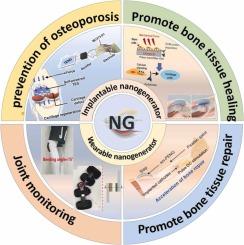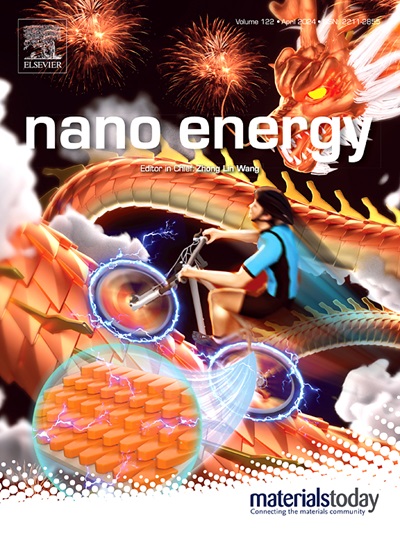纳米发生器在骨科中的应用进展:从体表到植入
IF 17.1
1区 材料科学
Q1 CHEMISTRY, PHYSICAL
引用次数: 0
摘要
纳米发电机是一种将机械能转化为电能的装置,广泛应用于可穿戴和健康领域。纳米发电机利用人体运动产生的机械能驱动纳米发电机,实现生物医学应用或健康监测。在这个过程中,纳米发电机通常利用摩擦电或压电效应来产生电能,即使在人体运动的小机械输入下也能实现高效的能量转换。在人体器官中,骨骼作为一种刚性支撑,往往保存着大量的动能,是剩余能量最丰富的器官。通过从骨骼中收集动能,纳米发电机可以提供一致的低功率能源,适合维持小型电子设备的长期运行。相关电信号还可用于监测骨骼、关节、肌腱等部位的运动姿态信息。本文综述了纳米发生器在骨科中的应用,其典型应用场景包括体内和体外。体内应用主要是传感和加速组织再生,而体外应用主要是可穿戴传感。在总结这些分类应用的基础上,提出了纳米发生器在骨科应用中存在的问题和前景。本文章由计算机程序翻译,如有差异,请以英文原文为准。

Recent advances in the application of nanogenerators in orthopedics: From body surface to implantation
Nanogenerators are devices that convert mechanical energy into electrical energy, which are widely used in wearable and health fields. Nanogenerators use the mechanical energy generated by human motion to drive nanogenerators to achieve biomedical applications or health monitoring. In this process, nanogenerators typically harness the triboelectric or piezoelectric effect to generate electrical energy, allowing efficient energy conversion even with small mechanical inputs from human motion. In human organs, bone, as a rigid support, often preserves a large amount of kinetic energy and is the organ with the most abundant residual energy. By collecting this kinetic energy from bones, nanogenerators can provide a consistent, low-power energy source, suitable for sustaining the long-term operation of small electronic devices. The related electrical signals can also be used to monitor the motion posture information of bones, joints, tendons, and other positions. Here, the application of nanogenerators in orthopedics is reviewed, and its typical application scenarios include in vivo and in vitro. In vivo applications are mainly sensing and accelerating tissue regeneration, while in vitro are mainly wearable sensing. On the basis of summarizing these classification applications, the problems and prospects of nanogenerators in orthopedic applications are also proposed.
求助全文
通过发布文献求助,成功后即可免费获取论文全文。
去求助
来源期刊

Nano Energy
CHEMISTRY, PHYSICAL-NANOSCIENCE & NANOTECHNOLOGY
CiteScore
30.30
自引率
7.40%
发文量
1207
审稿时长
23 days
期刊介绍:
Nano Energy is a multidisciplinary, rapid-publication forum of original peer-reviewed contributions on the science and engineering of nanomaterials and nanodevices used in all forms of energy harvesting, conversion, storage, utilization and policy. Through its mixture of articles, reviews, communications, research news, and information on key developments, Nano Energy provides a comprehensive coverage of this exciting and dynamic field which joins nanoscience and nanotechnology with energy science. The journal is relevant to all those who are interested in nanomaterials solutions to the energy problem.
Nano Energy publishes original experimental and theoretical research on all aspects of energy-related research which utilizes nanomaterials and nanotechnology. Manuscripts of four types are considered: review articles which inform readers of the latest research and advances in energy science; rapid communications which feature exciting research breakthroughs in the field; full-length articles which report comprehensive research developments; and news and opinions which comment on topical issues or express views on the developments in related fields.
 求助内容:
求助内容: 应助结果提醒方式:
应助结果提醒方式:


